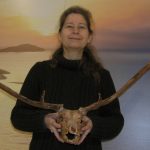
Alexandra van der Geer
Naturalis Biodiversity CenterAbout Me
I am a palaeontologist, specialised in aspects of evolution and biogeography of extinct mammals on islands. I am an indologist as well, specialised in the interface between human material culture and native faunas in South Asia. Since 2004 I have been working at the National and Kapodistrian University of Athens, Greece, and currently I work as a postdoc researcher (VENI2017) at Naturalis Biodiversity Center, Leiden, the Netherlands. Through my research on island mammals I collaborate with geologists, biogeographers, anatomists and archaeologists in attempting to reconstruct the evolution, adaptation and extinction of insular endemics globally and to investigate the role of humans. I've excavated at sites in Greece and Italy, and am currently expanding my research focus to include extant insular mammals, native as well as introduced, with emphasis on South East Asia and the Pacific. I have published over 50 papers and several books including Animals in Stone (2008) and Evolution of Island Mammals (2010).
https://science.naturalis.nl/en/people/scientists/alexandra-van-der-geer/
My Research
The fossil record holds spectacular examples of evolution in isolation, with pony-sized elephants, rabbit-sized mice, goats with teeth like those of rodents and many, many more. The how and why of these insular marvels is a case on its own, which I am trying to unravel. One way is by measuring, comparing and describing fossil species, sometimes in the context of insular populations of today. Another way is to study the evolutionary behaviour of a proxy species. Such a species needs to meet several requirements. First of all, it should have the potential to evolve rapidly. Second, it should have a wide distribution in time and space. Third, it should live on a multitude of islands with all kind of different variables (climate, size, other animals etc.). Four, and this is not trivial, material should be widely available in collections to study. The Polynesian rat (Rattus exulans) meets all requirements. It has been introduced to islands covering the entire Pacific as far as Easter Island (Rapa Nui) since c. 2,000 BCE and had ample time to adapt due to its prolific nature. It is a pest on most islands, so material is available indeed. My most recent research focus is on the evolution of this rat over its entire introduced range. The ultimate goal is to explain the evolution of the island giants of the deep past. Apart from this new research, I continue to study the fossil record of insularity with emphasis on the Mediterranean.
Capeia Articles
Selected Publications
2017 Van der Geer A.A.E., Lomolino M., Lyras G.A. Islands before man: the species-area relationship during the late Pleistocene. Journal of Biogeography 44, 995–1006. doi:10.1111/jbi.12857.
2016 Van der Geer A.A.E., van den Bergh G., Lyras G.A., Prasetyo U.W., Due R.A., Setiyabudi E., Drinia H. The effect of area and isolation on insular dwarf proboscideans. Journal of Biogeography 43, 1656–1666. doi:10.1111/jbi.12743
2015 Van der Geer A.A.E., Anastasakis G., Lyras G.A. If hippopotamuses cannot swim, how did they colonize islands: a reply to Mazza. Leithaia 48, 147–150. doi:10.1111/let.12095.
2014 Van der Geer A.A.E., Lyras G.A., MacPhee R.D.E., Lomolino M., Drinia H. Mortality in a predator-free insular environment: the extinct dwarf deer from Crete. American Museum Novitates 3807, 29 pp.
2014 Van der Geer A.A.E. Parallel patterns and trends in functional structures in island mammals. Integrative Zoology 9, 167–182. doi:10.1111/1749-4877.12066.
2014 Van der Geer A.A.E., Lyras G.A., van den Hoek Ostende L.W., de Vos J., Drinia H. A dwarf elephant and a rock mouse on Naxos (Cyclades, Greece) with a revision of the palaeozoogeography of the Cycladic Islands during the Pleistocene. Palaeogeography, Palaeoclimatology, Palaeoecology 404, 133–144. doi:10.1016/j.palaeo.2014.04.003.
2014 Van der Geer A.A.E., van den Hoek Ostende. De dwergolifant en de rotsmuis van het Vergeten Eiland. Cranium 31 (2), 31–34.
2013 Van der Geer A.A.E., Lyras G.A., Lomolino M., Palombo M.R., Sax D. Body size evolution of palaeo-insular mammals: temporal variations and interspecific interactions. Journal of Biogeography 40, 1440–1450. doi:10.1111/jbi.12119.
2013 Lomolino M.V., van der Geer A.A.E., Lyras G.A., Palombo M.R., Sax D., Rozzi R. Of mice and mammoths: generality and antiquity of the island rule. Journal of Biogeography 40, 1427–1439. doi:10.1111/jbi.12096.
2009 Lyras G.A., Dermitzakis M.D., van der Geer A.A.E., van der Geer S.B., de Vos J. The origin of Homo floresiensis and its relation to the evolutionary processes of insularity. Anthropological Science 117, 33–43. doi:10.1537/ase.080411.
2006 Van der Geer A.A.E., Dermitzakis M., de Vos J. Crete before the Cretans: the reign of dwarfs. Pharos 13, 121–132
2006 Lyras G.A., van der Geer A.A.E., Dermitzakis M.D., de Vos J. Cynotherium sardous, an insular canid (Mammalia: Carnivora) from the Pleistocene of Sardinia (Italy), and its origin. Journal of Vertebrate Paleontology 26, 735–745. doi:10.1671/0272-4634(2006)26[735:csaicm]2.0.co;2.
2006 Van der Geer A.A.E., de Vos J., Lyras G., Dermitzakis M. New data on the Pleistocene Cretan deer Candiacervus sp. II (Mammalia, Cervinae). In Kahlke R.-D., Maul L. C., Mazza P. (eds), Late Neogene and Quaternary biodiversity and evolution: Regional developments and interregional correlations. Proceedings of the 18th International Senckenberg Conference vol. II. Courier Forschungsinstitut Senckenberg 256, 131–137.
Recommended Reads
2010 Van der Geer A., de Vos J., Dermitzakis M., Lyras G. Evolution of Island Mammals: Adaptation and Extinction of Placental Mammals on Islands. Oxford, Wiley-Blackwell, c. 384 pp, 200 ill. ISBN 13-978-1-4051-9009-1.
2009 Van der Geer A., de Vos, J., Dermitzakis, M., Lyras, G. Hoe dieren op eilanden evolueren. Majorca, Ibiza, Kreta, Sardinië, Sicilië, Japan, Madagaskar, Malta. Wetenschappelijke Bibliotheek 98. Utrecht, Veen Magazines, 229 + ix pp., figs.; ISBN 978-908571 -169-8.